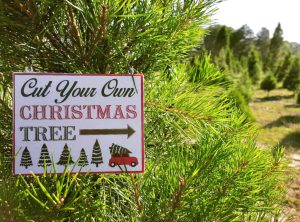
The holiday season is approaching quickly, and nothing feels more festive than decorating a live Christmas tree. You can purchase a pre-cut Christmas tree, cut one yourself at a local tree farm, or select a potted living tree. Cutting a live tree can be a fun outing at a local Christmas tree farm. Some locations in our area are listed below. Be sure to contact the business for dates and hours, and if tickets are required. Some farms also offer festive events for families and food.
- Lazy Lay Acres Christmas Tree Farm, 14920 Swift Road, Dade City, (941) 776-1480
- Ergle Christmas Tree Farm, 3331 Treiman Blvd Unit B, Dade City, (352) 583-3647
- Santa’s Christmas Tree Farm, 35317 Huff Rd, Eustis, (352) 357-9863
- Tappen Tree Farm, 3329 59th Dr E, Bradenton, (941) 776-1480
What if you prefer an artificial tree? Artificial trees can be less messy and easier to set up than live trees. Artificial trees may be a consideration for individuals with allergies to live trees. They can be higher-priced than live trees but can be reused for many years.
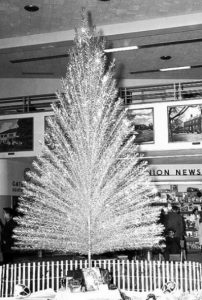
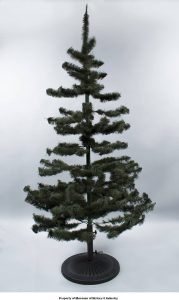
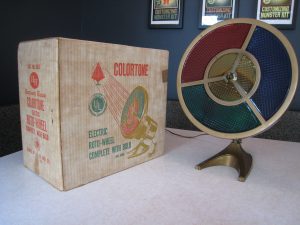
Artificial trees were first seen in Germany. Metal wire was fashioned as a tree and covered with goose, turkey, ostrich, or swan feathers. The pine needle look came from dying the feathers green. The first artificial trees, as we know them today, were produced by the Addis Brush Company in the 1930s, a company that manufactured toilet brushes. The company used the same machinery to manufacture toilet brushes and trees. The Addis “Silver Pine” tree was patented in 1950. Because it was metal and could not be strung with lights it had a revolving color wheel to produce different colors reflecting on the silver.
Most artificial trees end up in landfills when they go out of style, become worn or when attached lights stop working. Today artificial trees are made from plastic, metal, and even wood. Some artificial trees come from foreign sweat shops, and some have warning labels because they contain lead. In a number of consumer tests, they are not as inflammable as the fire-proof labeling indicates. The National Christmas Tree Association reports that “85% of fake trees in the U.S are imported from China and that they are made from a petroleum-based product manufactured primarily in Chinese factories. Additionally, the average family uses a fake tree for only six to nine years before throwing it away, where it will remain in a landfill indefinitely.” According to the Department of Commerce, in 2014 the US spent $138 million on imported fake trees and $1 billion on imported ornaments from China.
Real trees absorb carbon dioxide and other gases and emit fresh oxygen while they are growing. Real cut trees can be recycled or used in compost piles. Potted trees can be planted and continue to contribute to ecosystem services. A living Christmas tree is a version of the traditional Christmas tree and purchasing one supports U.S. growers, commerce and retail services. Below are tips for your real living Christmas tree.
Selecting a Tree
Know how much room you have. Remember, cut trees that are wrapped with netting may have a much larger spread once unwrapped. Look for signs of dryness by giving the tree a gentle shake or a thump on the ground. If a lot of needles drop the tree is too dry. Pine or fir varieties have stronger branches that can support heavy ornaments.
Cut trees should look green and have a strong scent (no candles or sprays needed to get that fresh pine scent). Have the tree lot cut a few inches off the stump. The fresh cut allows the tree to absorb more water keeping the tree moist delaying needle drop. Moist trees are less likely to catch fire.
Caring for Your Tree
Set up the tree in a sturdy stand. It’s important for the tree to get water within a few hours of cutting. If you can’t set it up right away, put it in a bucket of water. Check the water reservoir daily to make sure it’s full. Plenty of clean water keeps the tree healthy and green. A friend of mine uses a PVC pipe spray painted green and a funnel to fill the reservoir so he doesn’t have to maneuver under the tree to provide water. Place the tree away from heat and air conditioning vents and fireplaces that can dry out trees quickly. For easier cleanup, put a tree skirt under the tree to catch dropped needles.
Potted Trees
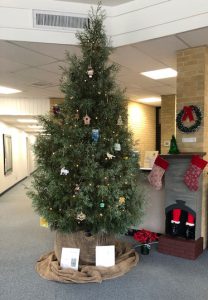
Species well-adapted for Florida include red cedar, Arizona cypress, sand pine, and junipers. Other tree species are not suited for Florida’s climate. Before you pick out your tree, make sure it’s one that will grow in Florida. Don’t dig up a live tree from your yard or the woods. It’s unlikely you will be able to dig up the entire root ball. Digging up can stress the tree, and cause transplant shock and tree death. National and state parks either prohibit removing trees or require a permit. The joy of a potted tree is that you can plant it after the season. When you choose a tree know the mature height and spread and make sure you have an area large enough to accommodate it. January is the best time to plant trees in Florida. If you can’t plant it, you can donate it.
The container will add height to the tree. For smaller spaces place a small container plant on a tabletop. Care for on a patio or deck after the season and bring it back in inside next year to decorate once again for the holidays. Be sure to keep the container soil moist to prevent drying out.
Christmas Tree Safety
To prevent your tree from catching fire, keep it away from heat sources such as fireplaces and radiators. A Detroit fire department demonstrated that a well-maintained live tree was more fire resistant than an artificial tree advertised as fire retardant. The artificial tree engulfed in flames, produced toxic smoke, and melted almost completely down. After putting out the fire the live tree remained mostly intact.
Never decorate with lighted candles as the flames can easily set a tree on fire. Only use indoor lights on your tree and check the lights annually for damage. Don’t plug more than three sets of lights into one extension cord. Invest in a timer so that lights turn off before you go to bed. Turn them off when you’re not at home. Clappers are a great innovation for Christmas lights. Just clap the lights on and off with out bending or reaching behind your tree.
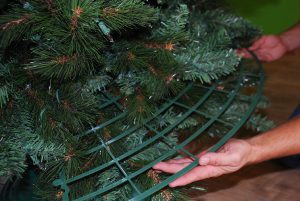
Christmas trees can be mildly toxic to pets. There is no need to add preservatives, pennies, aspirin, or any other substance to the reservoir water. All the tree needs is fresh water. Cats love climbing in trees, playing with, and knocking off ornaments and chewing on lights and branches. Many cats are injured or die from electrocution at Christmas. Eating needles can cause diarrhea and vomiting. What can you do? Confine your cat or use baby gates and blockades? Another product is the Christmas Tree Defender. This is a circular netted mat that’s installed in the lower branches and extends out from the trunk preventing cats from climbing your tree and accessing ornaments. It can be installed on live or artificial trees.
Disposal
When your tree becomes dry, it’s time to remove from your house to prevent the threat of fire. Experts recommend removing trees from homes by New Year’s Day. Don’t burn tree branches or needles in a fireplace or wood burning stove. Additionally, outdoor burning can be dangerous as a dry tree will ignite and become a blazing inferno in less than one minute. Be environmentally friendly by recycling your cut tree and planting your potted tree. As for artificial trees, perhaps they can be recycled as toilet brushes.
UF/IFAS Extension, University of Florida is an equal opportunity institution.
 2
2
